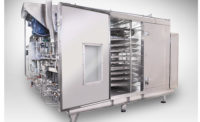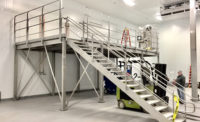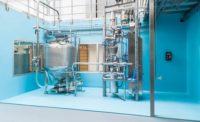Thermal management is crucial to processing, storing and delivering several types of snacks and baked goods. The latest systems cover a wide range of functions, including chilling dough, cooling product after exiting the oven, and refrigerating or freezing finished product. Specialized cold storage facilities also are part of the mix.
Food safety and hygiene are key factors driving new developments in thermal-management equipment. Given market trends, keeping product fresh is more important than ever. Demand for better-for-you options featuring minimally processed ingredients continues to increase. These criteria often dictate requirements for cold-storage capabilities that provide secure, short-term preservation of goods, and ensure quick delivery to distributors and consumers.
Cleaner processing
The trend toward gluten-free, artisan and better-for-you products is driving many bakery and snack producers to look at cryogenic solutions that use nitrogen or carbon dioxide to satisfy their chilling or freezing needs, according to Scott Robertson, industry manager-foods, Air Products and Chemicals, Inc., Allentown, PA.
“Cryogenics offers advantages, such as lower capital costs. Because it requires less floor space than mechanical chilling or freezing systems, processors are able to fit new production lines in existing spaces. In addition, cryogenics freeze or chill faster than traditional mechanical methods, providing higher-quality products,” Robertson says.
More producers want to control temperature at all phases of the process, so they can yield consistent, high-quality products year round, adds Robertson. “Traditional methods of adding chilled water or ice can impact product formulas,” he says. “By using cryogenic nitrogen or carbon dioxide for ingredient cooling (either in-line or batch), companies can produce consistent products year-round.”
Joe Bove, vice president, design, Stellar, Jacksonville, FL, sees two major trends impacting the cold-storage industry: a shift to natural refrigerants and heightened cross-contamination prevention to adapt to allergen-free foods.
“Legislation such as the Montreal and Kyoto Protocols are phasing out synthetics that are environmentally harmful. As the cold-storage industry continues to evolve, companies must switch to environmentally friendly options,” Bove says.
“Ammonia continues to be a popular natural alternative in refrigeration, and cascade refrigeration systems allow manufacturers to increase efficiency by using two centralized systems in unison,” says Bove. “However, because ammonia leaks are dangerous, it’s important for facilities that use ammonia refrigeration to have safety procedures in place.”
Safety is also a factor on the line. As more producers integrate allergen-free SKUs into their existing product lines, preventing cross-contamination becomes a big challenge, as dust particles from allergen-containing products can contaminate allergen-free products. “Dedicated allergen-free lines should ideally have their own refrigeration systems to keep products safe for consumers,” Bove adds.
Flexible and efficient
Among new systems available to bakery and snack producers, Air Products and Chemicals offers the Freshline IQ tunnel freezer. Its modular design allows the tunnel to be easily expanded so that food processors can increase its length to meet market demand. “The system has generated interest from bakery/snack producers, where ease of expansion and the ability to produce high-quality products while minimizing cryogenic usage is important,” Robertson says.
Praxair Inc., Danbury, CT, offers cryogenic freezing and chilling systems that take up little plant space and can be installed in a few days. PLC controls with programmable product recipes and data storage and sharing are available on the freezers. “Slow freezing can diminish quality and taste performance in bakery and snack food products. To combat this, cryogenic freezing quickly locks in flavor and quality to minimize any loss of the freshly baked taste,” says Frank J. Martin, marketing manager, food refrigeration.
In-line chilling of finished products also is an important application in a bakery process, adds Martin. To meet this need, a small cryogenic system can quickly set up coatings or frosting on finished goods to preserve a clean look through the packaging process.
“Many bakery and snack producers use Praxair’s flour cooling and dough cooling systems. Often, the same cryogenic supply system used for freezing can be used to control dough temperatures in mixers. This helps eliminate water ice addition and leads to optimum product temperature and improved product quality,” Martin says.
Praxair recently unveiled the ColdFront cryo-saver tunnel freezer, which reportedly provides up to 15 percent efficiency improvement over standard cryogenic freezers. The system design keeps room air out of the freezer and maximizes both heat transfer and cryogenic efficiency.
Filtrine Manufacturing Co., Keene, NH, offers three different types of bakery chillers: batch draw ingredient water chillers, jacketed mixer glycol chillers and batch draw/jacketed mixer water combination chillers, according to Turner Hansel, vice president. “The batch draw chiller offers uniform temperatures, supplying ingredient water at 34°F and maintaining temperature settings within a 1.5°F range,” he says.
“The jacketed mixer chiller circulates a water and glycol mix between the chiller and mixer to extract heat generated by high-speed mixing to provide a constant temperature,” says Hansel. “The third option is the ingredient/jacketed mixer combination chiller, which saves energy and space by including both in one compact unit. Dough mixing manufacturers often partner with Filtrine to develop a custom chiller design to work with their equipment.”
GEA Refrigeration Technologies GmbH, Bochum, Germany, recently introduced a temperature and evaporator feeding control for its line of chillers and freezers. The GEA ExactControl system automatically controls the chilling or freezing air temperature for each product processed on the line. “Energy savings can be achieved through the exact alignment of the refrigeration supply for chillers and freezers,” says Mathieu Nouhin, president.
Master-Bilt Products, New Albany, MS, has designed the Master-Chill Reach-In Blast Chiller, which is designed for high-capacity input. Each exterior wall is 2.95 inches thick to thoroughly insulate the chamber. The unit can chill 114 lbs. of product from 194°F to 37°F in a 90-minute cycle and 55 lbs. of product from 194°F to 0°F in 240 minutes.
A food identification controller automatically adjusts blast-chilling cycles with a single multi-sensor probe, according to Master-Bilt. This prevents surface freezing and degradation while preserving nutritional values of the food by monitoring temperatures in the core, beneath and on the surface.
Cool and in control
Snack and bakery equipment often poses thermal challenges to its very components, dictating the need for a method of cooling. Proper cooling is critical to the sensitive electronics used for controlling processes related to automation.
Such facilities also often feature fine particulates, such as flour, that can form a threat to equipment like air conditioners, especially in the makeup areas of a commercial bakery. The buildup of flour in the air conditioner can lead to reduced performance and eventual failure.
Air/water heat exchangers from Pfannenberg Inc., Lancaster, NY, offer a thermal-management solution for these situations. The heat exchangers operate in a fashion that doesn’t rely on ambient conditions, meaning that heat and particulate from the ambient air do not interact with the cooling process, protecting the electronics within the enclosure.
Heated air is drawn into the heat exchanger from the top of the enclosure, cooled in the heat exchanger’s water coil, and delivered at the bottom in keeping with natural air circulation. The wide separation between the air inlet and air outlet prevents short cycling of the airflow.
Maintaining the enclosure temperature helps equipment operate efficiently and extends the life of electronics especially in the makeup area or near the ovens, the company reports.
On the move
Conveyor systems play an integral role in proofing, cooling and freezing bakery products. Cambridge Engineered Solutions, Cambridge, MD, offers CamEdge, used in combination with an edge-driven spiral system that increases throughput. The cage-less system and spiral belt can be configured around building columns. “CamEdge utilizes a drive link on the outer edges to reduce component flexing during sprocket engagement. This extends belt life and lessens the chance of component fatigue,” says Crystal Willey, director of market development.
To meet sanitation standards, Cambridge works with OEMs to design belts to work with edge-driven systems. Because there is no cage, the system and its metal belts are open and easier to clean.
High-speed doors designed for cold-storage environments help maintain environmental temperature and minimize energy loss by reducing doorway exposure time and air infiltration. To that end, Rytec Corp., Jackson, WI, offers the Turbo-Slide insulated freezer door, a sliding door built to endure the rigorous demands of cold-storage environments. Offered in both sliding and bi-parting models, it features a strong perimeter edge for a secure seal along all edges.
Yale Materials Handling Corp., Greenville, NC, offers products from motorized hand products to order-selectors engineered to withstand harsh environmental conditions at temperatures as low as 40°F, notes Mick McCormick, vice president of warehouse solutions.
The Yale three-wheel stand, for example, features a multi-function control handle that is designed for use with bulky freezer gloves in subzero applications. “In addition, moisture is an important factor to consider in cold-storage operations, because it poses a threat to electrical components. Yale lift trucks are designed to keep moisture away from critical components,” McCormick says.
Looking at the future of cold-storage innovations, Nouhin see full process line automation—in conjunction with peak efficiency—as a major technological development over the next decade. “By measuring and recording product size, weight, texture, moisture, temperature and frozenness continuously, the freezer and refrigeration system will automatically provide the expected product quality with a minimum of energy consumption.”












